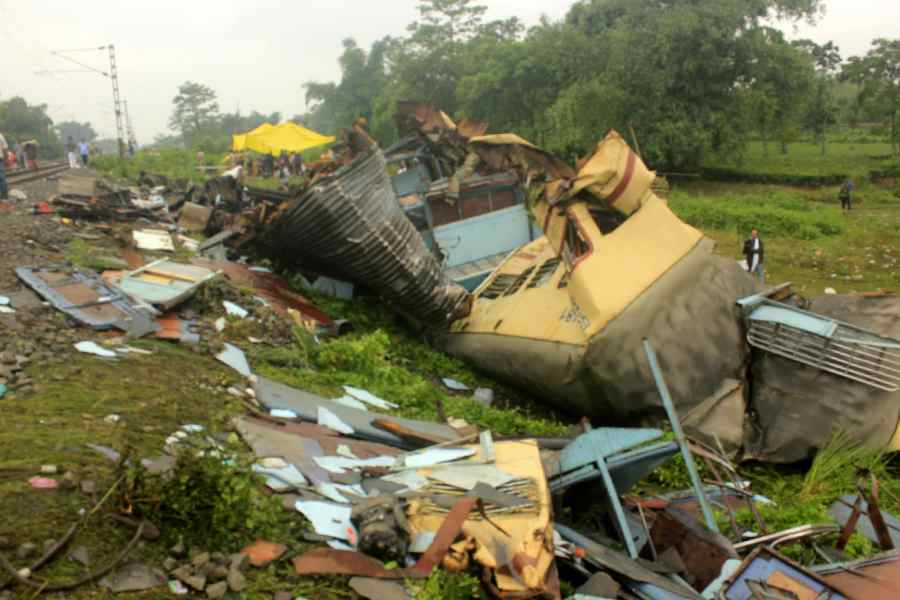The train accident in north Bengal on Monday has exposed the lack of coordination between the drivers and the station authorities and highlighted the need for extensive training to avoid such tragedies, several railway employees have told this newspaper.
The accident in which a goods train smashed into the rear of the Kanchenjunga Express near Rangapani station in Darjeeling district killed 10 people, including a six-year-old girl who died on Tuesday.
The railway authorities have initiated a probe into the accident that Railway Board chairperson Jaya Varma Sinha had initially linked to an error on the part of the driver of the goods train.
However, rail employees have in the last 48 hours flagged several operational issues in the Katihar division of the Northeast Frontier Railway (NFR).
Ramkishore Prasad Singh, secretary of the New Jalpaiguri (NJP) unit of the All India Loco Running Staff Association, told this newspaper that a “deficient training system” in the division — parts of which were upgraded to an automatic signalling system in recent years — was one of the biggest problems that the authorities must address immediately.
“Adequate training was not provided to the loco pilots, guards and station masters after the signalling system was changed to automatic mode on some stretches of the NFR.... We want the authorities to organise extensive training to avoid such accidents in future,” he said.
Surendra Kumar, the divisional railway manager of the Katihar division of the NFR, denied the charge without delving deep into the training issue.
“Such allegations come up whenever there is an unfortunate accident. But we do conduct necessary training. An inquiry into the accident is in progress and this matter would also be looked into,” he said.
After the accident, senior officials of the railway ministry had said that the driver of the goods train didn’t follow the standard operating procedure after he was provided with a PLCT (paper line clear ticket) to carry on with the onward journey through a stretch where the automatic signalling system was not working on Monday morning.
A senior loco pilot based in Siliguri mentioned that after the new signalling system was introduced on the Aluabari Road–NJP-Ambari Falakata stretch (where the accident took place) in November 2022, the chief loco inspectors (CLIs), under whom loco pilots and assistant loco pilots work, didn’t organise “adequate training” to familiarise them with the new system.
“Some counselling sessions were conducted in which we were provided titbits about the new system,” said the loco pilot, who refused to be identified as he was apprehensive of “disciplinary action” for speaking to the media on a sensitive issue.
According to him, the standard training module is elaborate and involves theoretical and practical classes, followed by written exams and interviews.
“After the training, certificates are provided to confirm that the driver concerned is proficient to run a train through a stretch where there is an automatic signalling system and also in case the system is not working,” he said.
In areas where there are no automatic signals, trains run under the “absolute block system” in which station masters allow only one train to move through a defined section at a time.
“Along the route of the Kanchenjunga Express, automatic signals exist from Sealdah to Masagram in East Burdwan.... Most stretches from Burdwan to Malda and even beyond have the traditional block system,” the loco pilot said, explaining how drivers need to switch from one system to another.
Multiple sources in the railways said Transportation Refreshers’ Training (TRT) is the standard norm for drivers once every three years. During the training, all aspects and rules to run trains in different signalling modes for single-line, double-line and multiple-line sections are discussed.
“As the automatic signalling system was installed in the section just a year and a half ago, it may happen that TRT could not be held during this period. The authorities now have to inquire whether the mandatory ‘learning-road’ training was given to those loco pilots and other staff involved in transportation,” said V.B. Singh of the Eastern Railway Trinamool Men’s Congress.
A retired loco pilot, who has worked in the railways for around 40 years, said the absence of proper training was bound to result in the lack of coordination among the various wings involved in the operations. “It is now emerging that the drivers were issued wrong forms to jump signals.... The fact that a goods train was allowed on the same stretch before the Kanchenjunga Express had crossed the area was a clear case of lack of coordination. Such non-coordination happens only when the staff are not properly trained, he said”
Several in-service loco pilots told this newspaper that it would be “unfair” to blame the drivers of the goods train.
“It is a collective responsibility and everybody has his own role to play in the operation... It is unfair to thrust the blame on someone who is dead,” said one of them.
He mentioned that the loco pilot of the goods train should have asked for the T/D 912 form, which is issued to allow a train to move through a section facing the problem of prolonged signal failure. “Instead, he accepted whatever (T/A 912 form) was issued to him. This again shows the lack of proper training,” he added.










